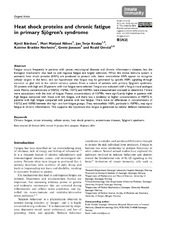| dc.description.abstract | Fatigue occurs frequently in patients with cancer, neurological diseases and chronic inflammatory diseases, but the biological mechanisms that lead to and regulate fatigue are largely unknown. When the innate immune system is activated, heat shock proteins (HSPs) are produced to protect cells. Some extracellular HSPs appear to recognize cellular targets in the brain, and we hypothesize that fatigue may be generated by specific HSPs signalling through neuronal or glial cells in the central nervous system. From a cohort of patients with primary Sjögren’s syndrome, 20 patients with high and 20 patients with low fatigue were selected. Fatigue was evaluated with a fatigue visual analogue scale. Plasma concentrations of HSP32, HSP60, HSP72 and HSP90α were measured and analysed to determine if there were associations with the level of fatigue. Plasma concentrations of HSP90α were significantly higher in patients with high fatigue compared with those with low fatigue, and there was a tendency to higher concentrations of HSP72 in patients with high fatigue compared with patients with low fatigue. There were no differences in concentrations of HSP32 and HSP60 between the high- and low-fatigue groups. Thus, extracellular HSPs, particularly HSP90α, may signal fatigue in chronic inflammation. This supports the hypothesis that fatigue is generated by cellular defence mechanisms. | en_US |

